Metro Dubai Timings: A Detailed Guide for Travelers
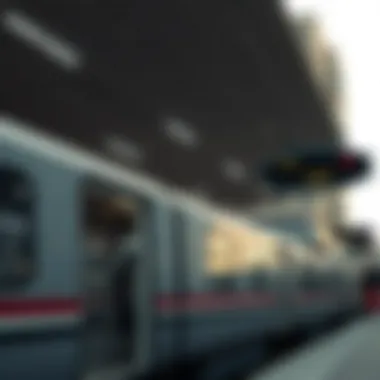
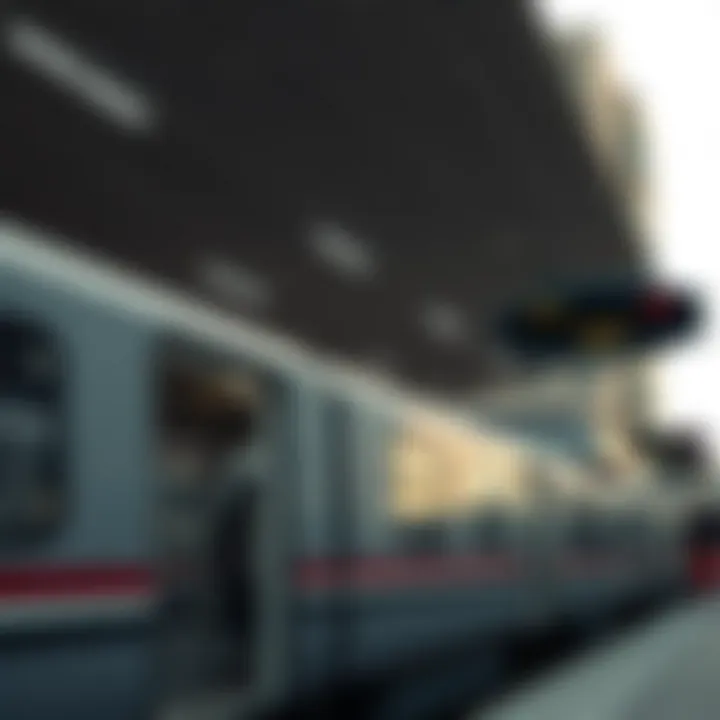
Intro
Dubai's Metro system is a marvel of modern engineering, providing efficient and swift transportation across one of the world's most dynamic cities. Understanding the current operational timings of the Metro holds significant importance for both locals and visitors, influencing daily routines and leisure activities. The Metro operates as a critical artery, connecting various neighborhoods, business districts, and tourist attractions. Muddling through traffic might feel like a Sisyphean task, but with the Metro, residents and tourists alike can glide through the city with ease.
By familiarizing oneself with Metro timings, individuals can plan their journeys more effectively, minimize wait times, and respond to the ebb and flow of the city’s vibrancy. With routes that stretch across key locations, accurate timing information is not just a convenience; it's a necessity that shapes commuting habits and influences the overarching urban landscape.
In this article, we'll delve into diverse facets related to the Metro’s operational schedule, touching on peak hours, routes, its implications on local infrastructure, tourism trends, and the real estate landscape in Dubai. We'll also explore how an astute understanding of transport schedules can bolster investment decisions, particularly for those eyeing property in burgeoning neighborhoods.
In short, getting a handle on Dubai's Metro timings can mean the difference between a smooth commute and a chaotic day - a truth that can't be overstated as we navigate these vibrant streets.
Understanding Metro Dubai's Operational Framework
When it comes to navigating the bustling urban landscape of Dubai, the role of the Metro system cannot be overstated. Understanding the operational framework of Metro Dubai is crucial for several reasons. It not only helps residents and visitors plan their journeys effectively, but it also sheds light on the city’s underlying infrastructure and growth strategies.
Importance of Metro Operations
The Metro serves as a backbone for public transport in Dubai, connecting numerous vital areas throughout the city. This framework allows for timely, efficient travel across a geographical area that continues to expand at a rapid pace. Benefits of understanding the operational framework include:
- Improved Travel Efficiency: Knowing the schedules and routes means less wasted time waiting for trains.
- Enhanced Planning for Events: With an understanding of peak and off-peak times, individuals can avoid crowded train stations.
- Economic Insights: Metrics around usage and timing can signal trends in local business and real estate developments.
From government planning to daily commuting, the Metro’s scheduling impacts a wide array of activities that ripple out into various social and economic realms.
Foreword to Dubai's Metro System
Dubai's Metro system made its debut on September 9, 2009, marking a significant milestone in the Emirate's transport network. This state-of-the-art system has not only redefined commuting patterns but also set the stage for comprehensive urban development. With two main lines, the Red and Green lines, covering over 75 kilometers, the Metro connects major areas like the Dubai International Airport, Dubai Mall, and residential districts. More than just a means to travel, it stands as a symbol of Dubai's commitment to modern public transit.
Features of Dubai's Metro:
- Driverless Operations: One of the few fully automated metro systems in the world.
- State-of-the-Art Technology: Equipped with advanced signaling and communication systems.
- Accessibility: Facilities for people with disabilities, ensuring inclusivity.
These components highlight not just the efficiency of the system but also illustrate Dubai’s vision for sustainable transport options, something imperative in today’s fast-paced environment.
Historical Timeline of Metro Development
Looking back at Dubai’s Metro development provides insight into how rapidly and effectively the city has embraced modern transportation solutions. The ambition behind the project dates back to the early 2000s when the Dubai government recognized the need for a comprehensive public transport system.
Key Milestones:
- 2005: The Dubai Roads and Transport Authority was established to oversee the Metro project.
- 2006: Construction began, aiming to revolutionize urban movement within a glorious city.
- 2009: The first section of the Red Line officially opened.
- 2011: The Green Line was launched, enhancing connectivity for neighborhoods.
Understanding this timeline is vital, as it shows the strategic planning and execution required to build a transport network that accommodates a growing populace. As Dubai continues to expand both geographically and demographically, so too must its Metro system evolve to meet new demands.
"Dubai's Metro system exemplifies the city's vision of integrating transport innovation with urban planning, a role that will become increasingly pivotal as the city grows."
Today’s Metro Timings: An Overview
Understanding the operational timings of the Metro Dubai is integral for both residents and visitors navigating the city. The Metro serves as a lifeline, connecting the different neighborhoods of this bustling metropolis to major attractions, business hubs, and essential services. With Dubai’s rapid expansion and a steady influx of travelers, knowing the Metro timings can significantly enhance travel efficiency and experience.
Daily schedules dictate how easily one can traverse the city, making it critical to identify the best times for travel. This information not only aids in planning itineraries but also influences peak travel behaviors, which in turn can impact local businesses and real estate.
Weekday vs Weekend Timings
In Dubai, the Metro operates on slightly different schedules during weekdays compared to weekends. Weekday timings generally cater to the commuter crowd—business professionals, students, and anyone else who needs to reach work or school. The Metro typically runs from 5:00 AM until midnight, with trains arriving every few minutes during peak hours, ensuring a steady flow of people.
Contrarily, weekend timings reflect a more relaxed pace. Operating hours often extend to 1:00 AM, accommodating those late-night gatherings or events. Weekend schedules usually have a longer interval between trains, as the ridership typically includes leisure travelers heading to the city’s attractions, shopping malls, and entertainment areas.
Notably, these different schedules also point to the broader economic activities in play:
- Weekdays: High traffic due to working populace
- Weekends: Leisure-driven travel, allowing families and tourists to explore
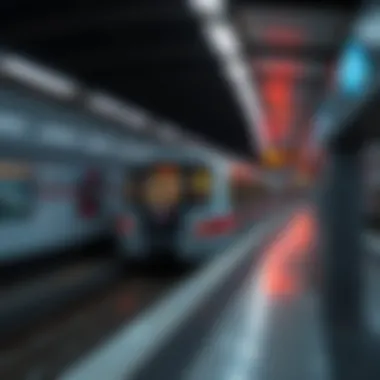
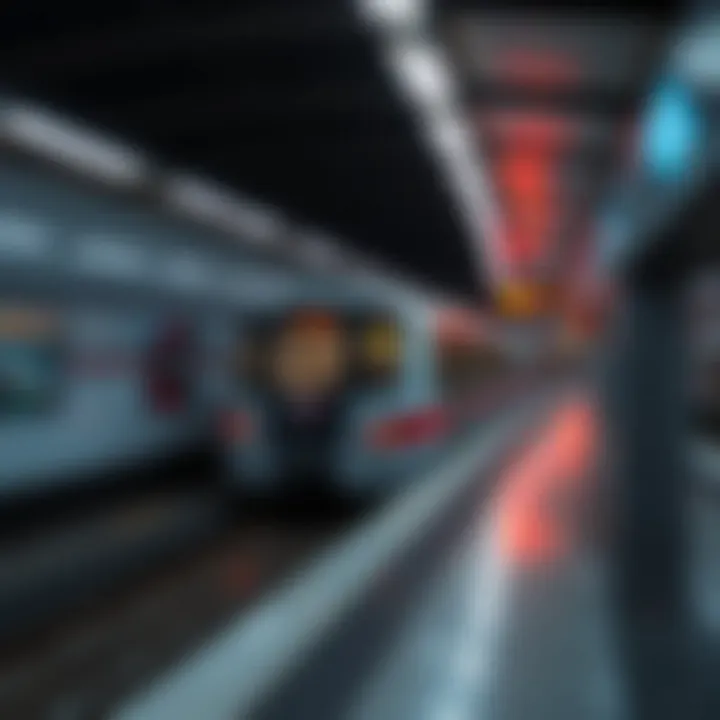
Peak Hours and Off-Peak Timings
Timing can make all the difference when it comes to the Metro's crowdedness. Peak hours during weekdays generally span from around 7:00 AM to 9:00 AM and again from 4:30 PM to 6:30 PM. During these windows, the trains can be packed to the brim. Understanding these times can save one from the discomfort of jostling through crowds.
On the other hand, off-peak timings are ideal for those looking for a quieter ride. Trains tend to run less frequently, yet provide a more relaxing environment for travel. Off-peak hours typically lie outside the peak timeframes, making it easier to find a seat and enjoy the ride without the hustle and bustle.
"A wise traveler knows when to embark and when to sit tight. Timing is everything."
By strategically planning trips around these operational hours, individuals can not only minimize travel time but also enhance their overall experience in Dubai. An understanding of Metro timings reveals much about the daily rhythms of the city—from bustling commutes to leisurely weekend outings.
Metro Routes: A Detailed Exploration
Understanding the layout and operational detail of Metro Dubai's routes is fundamental in comprehending how the system functions and serves the sprawling urban environment. A systematic look at the routes is essential for both everyday commuters and potential investors, shedding light on accessibility, convenience, and the overall implications for property markets around the metro stations. Metro Dubai comprises two major lines that connect key areas of the city and beyond, with the Red Line and Green Line standing out for their extensive reach and strategic significance.
Red Line Overview
The Red Line stretches approximately 52.1 kilometers and connects diverse neighborhoods, from Rashidiya in the east to UAE Exchange in the west. It's a lifeblood for many residents and tourists, facilitating movement through significant commercial and residential districts. This line passes through iconic landmarks such as the Burj Khalifa and the Dubai Mall, making it a vital artery for transportation.
Key Features of the Red Line:
- Stations: There are 29 stations, including major interchanges that allow seamless transitions to different modes of transport.
- Accessibility: The line offers access to numerous hotels and shopping areas, which is crucial for tourists and business travelers.
- Technology: Equipped with advanced signaling systems and automated trains, the Red Line follows stringent safety protocols ensuring comfortable and timely travel.
The Red Line operates from 5:00 AM to midnight during the week and has extended hours on weekends. Understanding the timing for this route could make or break a travel experience for many. Additionally, the ease of access facilitates not just everyday commuting but potential interest in property investment within its vicinity, drawing attention from real estate investors aiming to capitalize on high foot traffic in nearby areas.
Green Line Overview
The Green Line, while shorter at about 22.5 kilometers, complements the Red Line's service, connecting key residential areas with central business districts. It runs from Etisalat in the northeast to Dubai Creek in the southwest. The Green Line is pivotal for those who live in or visit these regions, as it enhances inner-city travel by providing additional routes and options.
Significant Features of the Green Line:
- Stations: The Green Line includes 20 stations, connecting local neighborhoods with central hubs.
- Intermodal Connectivity: This line links with the Red Line at several junctions, promoting efficient transfers.
- Cultural Access: Stops near cultural and heritage sites, enabling tourists and locals to easily visit attractions such as Al Fahidi and the Dubai Museum.
The operational hours for the Green Line are similar to the Red Line, which allows for flexibility in commuting. For those considering living near these lines, knowing about their connectivity and routes is essential, as this can influence the desirability of homes and their subsequent values.
Factors Influencing Metro Timings
Understanding the factors that affect the metro timings in Dubai is crucial for anyone relying on this transport system. These factors are not mere technical aspects but play a significant role in shaping user experience, operational efficiency, and overall satisfaction. Proper consideration of these elements can help commuters, tourists, and investors alike make informed decisions concerning their travel plans.
Maintenance Schedules and Their Impact
Maintenance is the heart and soul of the Metro’s reliability. Just like you wouldn't ignore a warning light on your car dashboard, the Metro system cannot overlook maintenance needs. Regular upkeep ensures that trains run smoothly, preventing unexpected breakdowns. The timing for these maintenance checks can substantially alter the usual metro schedule.
- Preventive Maintenance: Scheduled inspections often take place during off-peak hours. That way, disruptions during rush hour are minimized. Understanding these schedules helps commuters plan better.
- Emergency Repairs: Occasionally, unforeseen issues may arise, requiring immediate attention. Such repairs can lead to delays or temporary service cancellations. Staying updated on the road works is advisable through official channels.
"Routine checks keep the trains on the tracks, but a sudden hiccup can throw a wrench in the works."
These schedules are vital in influencing not only the timings but also the frequency of service. For example, after major events or during the yearly maintenance shutdowns, timings can shift dramatically, highlighting the importance of staying informed.
Event-Based Timings Adjustments
In a bustling city like Dubai, events can pop up like daisies in spring. Major festivals, sports events, or exhibitions attract large crowds, leading to the necessity for metro adjustments. The metro management often modifies timings to accommodate the influx of passengers during these events.
- Extended Hours: During popular events, the Dubai Metro may run longer hours, ensuring that late-night revelers have a way home. Such extensions can make a world of difference in terms of accessibility and convenience.
- Increased Frequency: More trains may be deployed on busy routes to ensure that no one is left standing. Knowing these adjustments ahead of time lets travelers plan effectively, especially if they are on a tight schedule.
- Event-Specific Routes: Sometimes, routes may be adjusted to cater directly to event venues. Familiarizing oneself with these changes can turn what might have been a long wait into a seamless transition from one point to another.
Resources for More Information
For real-time updates and information about Metro schedules in Dubai, consider checking:
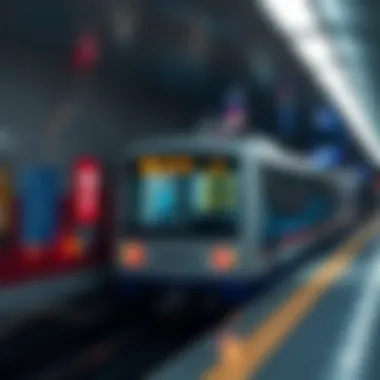
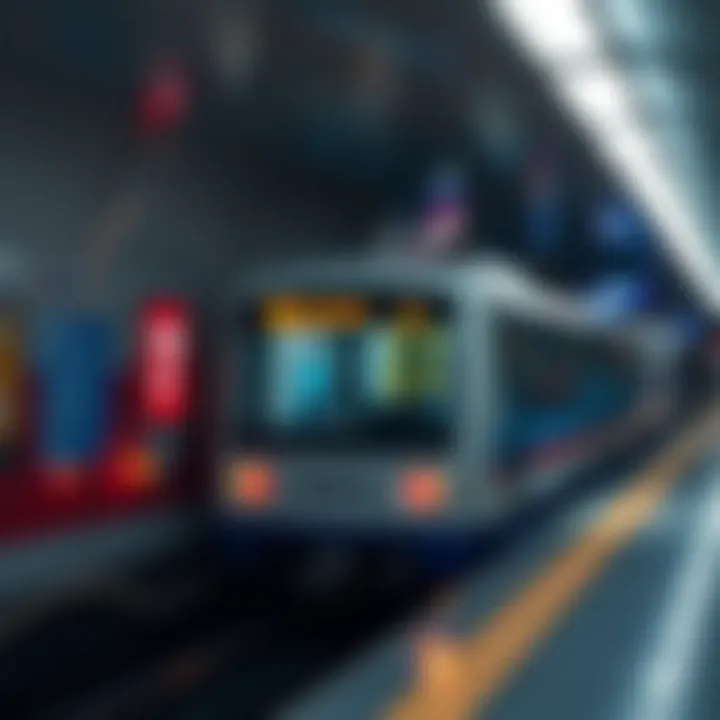
Staying informed with these schedules not only enhances your travel experience but also provides deeper insights into how these factors shape Dubai's urban fabric.
Navigating Metro Dubai: Tips and Recommendations
Navigating the Dubai Metro can be a daunting task, especially for newcomers. This section will equip travelers with essential tips and recommendations to help them navigate this vibrant system efficiently. Understanding how to utilize the metro not only enhances personal travel experiences but also contributes significantly to the broader context of urban mobility in Dubai.
Best Practices for Travelers
Being prepared is half the battle. Here are some tried-and-true tips for making the most of your Metro experience in Dubai:
- Plan Ahead: Familiarize yourself with the Metro map and routes prior to your journey. Knowing your starting point and destination can save time.
- Off-Peak Travel: Whenever possible, travel during non-peak hours. This means avoiding the rush hours of 7 a.m. to 9 a.m. and 5 p.m. to 7 p.m. It makes for a more comfortable experience.
- Metro Etiquette: Keep quiet on trains. Avoid using your phone in loud tones and give priority seating to elderly and disabled passengers.
- Use the Right Ticket: Make sure to purchase the correct NOL card based on your travel needs. The general-purpose NOL card is usually sufficient, but variations exist for tourists and frequent users.
- Stay Aware of Closing Times: Since Metro operations can change, especially during holidays, it’s crucial to stay updated with the latest timings.
These best practices not only streamline the travel experience but also enhance safety, allowing individuals to traverse the city painlessly.
Utilizing the RTA App for Real-Time Updates
In today's fast-paced world, having access to real-time information can make or break your travel plans. The Roads and Transport Authority (RTA) app offers a suite of features designed to make navigating Metro Dubai significantly easier.
- Live Timings: Use the app to check live train timings. This is especially beneficial if you're in a hurry or if unexpected delays occur.
- Route Planning: Enter your starting point and destination to get suggested routes, estimated travel times, and any potential transfers needed.
- Alerts and Notifications: The app can send alerts about service changes, including any disruptions or closures that may affect your route.
- Payment Integration: Reload your NOL card directly via the app, ensuring you always have sufficient balance without the hassle of finding a station kiosk.
Having this application at your fingertips can dramatically improve your experience and efficiency while using the Metro.
"A well-informed traveler is always the best navigator. Knowing how to adapt to changes, especially in a bustling hub like Dubai, can make your journey all the more enjoyable."
Whether you're a local resident or a tourist in Dubai, taking advantage of the RTA app and adhering to best practices will not only enhance your own commuting experience but also contribute to a more organized public transport system.
The Metro's Role in Dubai's Urban Landscape
The Metro system in Dubai isn't just about whizzing from one corner to another. It holds a pivotal role in shaping the urban framework of this sprawling metropolis. As urban areas continue to burgeon, efficient transportation becomes more than luxury; it is a necessity. The Metro provides an organized, cost-effective travel option that bolsters economic growth while addressing the challenges of traffic congestion and environmental concerns.
Impact on Local Transportation
Local transportation in cities can often resemble a jigsaw puzzle with missing pieces. However, the advent of Dubai's Metro was akin to inserting a high-quality piece into that puzzle. With its two main lines—the Red Line and the Green Line—residents and tourists alike can traverse the city efficiently, reducing the dependency on personal vehicles.
- Reduced Traffic Congestion: A major benefit of the Metro is its tangible impact on road traffic. By offering a reliable alternative to conventional car travel, it has noticeably alleviated the notorious congestion Dubai is often known for. Less time spent on the road results in more productivity for everyone.
- Sustainable Urban Mobility: The Metro also promotes a more sustainable transport model. With fewer cars on the road, emissions are reduced—and let's face it, cleaner air is good for everyone. People are starting to rethink their travel habits, shifting towards more environmentally friendly options.
- Integration with Bus Systems: The Metro works hand-in-hand with the local bus services, creating a seamless transport network. Passengers can easily switch from the Metro to buses, which further extends their reach across the city. This level of connectivity ensures that even outlying areas aren't left in the dust.
Enhancing Access to Residential Areas
The growing population of Dubai has led to an emphasis on providing accessible transportation options that can meet the demands of its residents. The Metro serves as a lifeline, particularly for those residing in areas that might not have been serviced as well by traditional transport routes.
- Targeted Development: Areas near Metro stations have seen a surge in development, with new residential complexes springing up. This increases property value in these regions, as proximity to public transport is often a compelling factor for buyers.
- Improved Connectivity: Whether it is commuting to work or visiting local amenities, the Metro offers unparalleled access. Places that once took ages to reach can now be just a few stops away. This encourages more people to live further from work, knowing that a quick ride can get them there in no time.
- Supporting Urban Growth: With enhanced connectivity attracting new residents, local businesses benefit too, creating a ripple effect throughout the economy. Coffee shops, grocery stores, and other essential services often set up shop nearby, establishing vibrant community hubs that nurture local culture.
"The Metro has transformed commuting in Dubai—making travel not just easier but part of the city’s very fabric."
As we explore the various facets of the Metro's influence, it transcends mere transport; it is a crucial player in economic growth, sustainability, and community engagement. Understanding this role helps both prospective buyers and investors appreciate the importance of location and accessibility in their real estate decisions.
Real Estate Implications of Metro Timings
Understanding the interplay between Metro timings and real estate is crucial for anyone involved in property investment, whether you are a buyer, an agent or an analyst. The Metro system in Dubai is not just a mode of transport; it is a catalyst for urban development and a significant influencer of property values. As the city continues to expand, the proximity and accessibility of metro stations can greatly affect the desirability of residential and commercial properties.
Understanding Market Dynamics
The real estate market in Dubai is a reflection of various dynamics, and the timing of the Metro plays a critical role in shaping these trends. When discussing market dynamics, numerous factors should be taken into account:
- Supply and Demand: Areas around Metro stations typically see a rise in demand due to easy access to transport. Buyers and tenants often value convenience, prioritizing properties near public transport.
- Investment Trends: Investors are keenly observing how Metro timings influence commuting patterns, leading them to make strategic decisions. For example, properties in areas with longer operational hours may attract more interest, offering greater rental income potential.
- Shifts in Population: Metro expansion often coincides with demographic shifts. As more people migrate to accessible neighborhoods, property demand increases, pushing prices higher.
In Dubai, neighborhoods such as Downtown and Dubai Marina have flourished due to their closeness to metro stations. These areas have seen not only enhanced property values but also vibrant communities formed around convenient transport links.
Property Value Correlation with Metro Accessibility
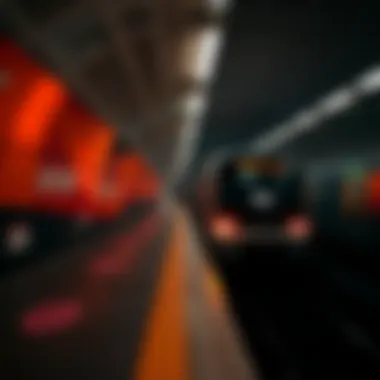

The correlation between property value and Metro accessibility is pronounced in Dubai’s real estate market. Potential buyers and tenants are willing to pay a premium for properties situated near metro lines, recognizing the advantages that come with it. Here’s how accessibility influences property values:
- Convenience Factor: Properties near metro stations are seen as more desirable. This demand translates into higher property prices and rental values, as residents prefer quick commutes over longer travel times.
- Development Surge: Areas undergoing metro construction often experience a temporary dip in property prices, but historically, these values rebound significantly once the services become operational. Post-launch periods usually witness spikes as people scramble to secure accommodations nearby.
- Enhanced Retail Opportunities: Properties within close proximity to Metro stations often attract retail and service businesses, which boosts local economies and, subsequently, real estate values. Investors recognize this potential and actively seek commercial properties in such locations.
“Proximity to public transport such as the Metro can elevate property prices by up to 20% in bustling locales, making it a crucial consideration for investors.”
Tourism and Metro Utilization
In the ever-bustling metropolis of Dubai, the Metro system has evolved into not just a mode of transport but a means of enhancing the tourism experience. Understanding how the metro operates and its relationship with tourism benefits both travelers and the economy at large. With modern infrastructure, the Metro provides affordability and convenience, allowing visitors to explore the city with ease. This section delves into the critical elements and benefits of Metro utilization for tourists visiting Dubai.
Transportation for Tourists
Navigating a new city can be a daunting task, but Metro Dubai simplifies this process significantly. The Metro spans much of the city and connects key attractions, making it a lifeline for tourists.
- Cost-Effective Travel: Unlike private taxis, which can drain a traveler's wallet, the Metro offers an economical option. Visitors can purchase a Nol Card, which provides access to all metro lines, buses, and boats with one easy card. This streamlines transportation, reducing the hassle of cash transactions.
- Time Efficiency: The Dubai Metro operates frequently, significantly reducing wait times compared to road transport, especially during rush hour. Many tourists take advantage of this by planning visits around the Metro schedule, maximizing their sightseeing opportunities.
- User-Friendly Experience: With multilingual signage and announcements, navigating the Metro is straightforward. This ensures that non-Arabic speakers can find their way without feeling lost or confused.
Tourists can hop on a train and be whisked away to various sites in minutes, allowing for a richer, more fulfilling experience without the stress of getting stuck in traffic.
Prominent Destinations Accessible via Metro
The strategic layout of the Metro system means that numerous attractions are mere stops away. Here are some key destinations easily accessible to those using the Metro:
- Dubai Mall and Burj Khalifa: As one of the world's largest shopping malls, a visit to Dubai wouldn't be complete without a trip here. A short ride to the Burj Khalifa Metro Station places visitors right at the entrance of these iconic landmarks.
- Dubai Marina: Enjoy stunning waterfront views and a vibrant atmosphere. The Metro provides a direct line to this exhilarating destination, making it a hotspot for evening strolls and dining by the water.
- The Global Village: Known for celebrating global cultures, this attraction can be reached within a reasonable distance from the closest Metro station, making it easy to immerse in the festivities.
- Al Fahidi Historic District: For those interested in exploring the rich history of Dubai, this neighborhood is a ride away, offering a glimpse of the emirate's traditional lifestyle.
- Jumeirah Beach: Sun-seekers can get off at the nearby station, with a short walk leading them to one of the city's most popular beaches.
"Using the Metro is like having a personal guide to all of Dubai’s hotspots. One moment you're in a bustling mall, and the next, you're gazing at the ocean."
For further information on the Metro system, visit the official RTA website.
Future Developments and Adjustments
As Dubai continues to grow and evolve, the necessity for improving and adjusting the Metro system becomes ever more critical. Future developments in Metro Dubai are not just about expanding routes or increasing the number of trains; they tap into a broader vision of connectivity, efficiency, and technological integration. Residents, visitors, and investors alike benefit from these changes, making it essential to keep an eye on how the Metro is adapting.
Anticipated Expansion Plans
The Dubai Metro has ambitious plans for expansion. The current network, comprising the Red Line and Green Line, is already extensive, yet city planners have some future routes in the pipeline that aim to fortify links between key areas and upcoming developments.
- Additional Lines: Plans are in place for several new lines, including a further extension of the Red Line to connect with the Expo 2020 site, which is now initiated.
- Connecting to New Districts: New residential and commercial districts like Dubai Creek Harbor are also on the radar, providing vital transport links that could enhance property values around these areas.
- Increased Capacity: The introduction of longer trains and more frequent services is rumored, which would alleviate congestion and make commuting much smoother during peak hours.
These upcoming changes emphasize not just the intention to make travel easier but also a strategic alignment with the larger urban planning goals of Dubai. With mid-size and high-density developments expanding in various sectors, the anticipated Metro expansions play a crucial role in supporting sustainable city growth.
Innovations in Metro Technology
The Metro's evolution isn't purely about reaching new locations; it's equally about how it operates. Innovations in technology are setting the stage for a more intelligent and user-friendly public transport experience.
- Smart Ticketing Systems: The RTA has plans to implement a more advanced ticketing system utilizing contactless payments and mobile applications. This would facilitate easier access for travelers, eliminating the need for physical ticket machines.
- Real-Time Data Integration: Technologies such as AI and big data analytics are becoming core components to improve route efficiency. By analyzing travel patterns, the Metro can better manage its schedule and respond dynamically to passenger demand.
- Sustainability Measures: Emirates Global Aluminium has partnered with the RTA to explore greener energy options for train operations, marking a significant move toward more sustainable public transport solutions.
Collectively, these innovations will not only enhance user experience but also position the Metro Dubai as a smart city pioneer. Incorporating such advancements directly correlates with the requirements and expectations of a modern, tech-savvy population.
As Dubai aims to uphold its reputation as a leading global city, the future developments and adjustments to its Metro system will significantly impact urban mobility, real estate values, and the overall quality of living.
Concluding Thoughts on Metro Timings in Dubai
The exploration of Metro timings in Dubai underscores its significance in enhancing the urban commuter experience. In a city known for its rapid growth and architectural marvels, understanding how Metro schedules operate is crucial for both locals and visitors. The Metro serves as a foundational aspect of public transport, weaving through the fabric of daily life and impacting various sectors like real estate and tourism.
Summary of Key Insights
Key insights drawn from the analysis reveal several empirical truths about Metro Dubai's operational timings:
- Consistency and Reliability: The Metro often runs on a set schedule, which ensures commuters can depend on it to reach their destinations without unnecessary delays.
- Weekday vs Weekend: Metro timings fluctuate between weekdays and weekends, catering to differing levels of demand. This variability highlights the need for awareness of these schedules to avoid peak hour congestion on busy workdays.
- Peaks and Off-Peaks: During peak hours, the service frequency increases, accommodating the workforce, while off-peak hours offer a quieter journey, making it ideal for leisure travelers or those running errands.
- Maintenance Impact: Scheduled maintenance can occasionally align with Metro timetables, affecting service; thus, commuters should keep abreast of updates to avoid disruptions.
- Tourism Influence: Tourists benefit greatly from the Metro's extensive coverage of key attractions, which translates to ease of access and enhanced travel experience.
"A well-informed passenger is a happy passenger. Knowing the ins and outs of the Metro means smoother navigation through Dubai's bustling life."
Final Recommendations for Travelers and Investors
For those looking to navigate Metro Dubai or invest in property near its routes, several recommendations can enhance your experience:
- Plan Ahead: Always check the Metro timings before heading out, especially if you're traveling during holidays or major events. The RTA (Roads and Transport Authority) app can give you real-time updates.
- Utilize Off-Peak Travel: If possible, schedule your travel during off-peak times to enjoy less crowded conditions and quicker rides.
- Consider Proximity to Metro Stations: When looking at property investments, prioritize locations close to Metro stations. Access to public transportation significantly boosts property value and desirability.
- Familiarize with Routes: Understanding which Metro lines connect to key destinations can make your experience smooth and efficient.
- Stay Informed on Future Developments: Keep an eye on upcoming expansions or technology upgrades to the Metro system, as these changes could impact travel and property dynamics over the next decade.



